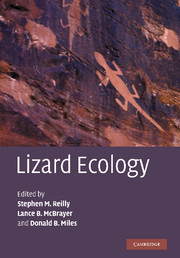Book contents
- Frontmatter
- Contents
- List of contributors
- Preface
- Historical introduction: on widely foraging for Kalahari lizards
- I Organismal patterns of variation with foraging mode
- II Environmental influences on foraging mode
- 12 The foraging biology of the Gekkota: life in the middle
- 13 Foraging mode in the African cordylids and plasticity of foraging behavior in Platysaurus broadleyi
- 14 Interactions between habitat use, behavior, and the trophic niche of lacertid lizards
- 15 Food acquisition modes and habitat use in lizards: questions from an integrative perspective
- 16 The evolution of foraging behavior in the Galápagos marine iguana: natural and sexual selection on body size drives ecological, morphological, and behavioral specialization
- 17 The evolution of the foraging mode paradigm in lizard ecology
- Index
- References
12 - The foraging biology of the Gekkota: life in the middle
Published online by Cambridge University Press: 04 August 2010
- Frontmatter
- Contents
- List of contributors
- Preface
- Historical introduction: on widely foraging for Kalahari lizards
- I Organismal patterns of variation with foraging mode
- II Environmental influences on foraging mode
- 12 The foraging biology of the Gekkota: life in the middle
- 13 Foraging mode in the African cordylids and plasticity of foraging behavior in Platysaurus broadleyi
- 14 Interactions between habitat use, behavior, and the trophic niche of lacertid lizards
- 15 Food acquisition modes and habitat use in lizards: questions from an integrative perspective
- 16 The evolution of foraging behavior in the Galápagos marine iguana: natural and sexual selection on body size drives ecological, morphological, and behavioral specialization
- 17 The evolution of the foraging mode paradigm in lizard ecology
- Index
- References
Summary
Introduction
Although the basic dichotomy in lizard foraging modes established by Pianka (1966) has become a paradigm supported by decades of subsequent research, not all lizards can be neatly characterized as either sit-and-wait predators or wide foragers. Although some (perhaps even most) lizard species may indeed fit relatively conveniently into one of these categories, the recognition that foraging mode can change in different habitats (Polynova and Lobachev, 1981; Ananjeva and Tsellarius, 1986), seasonally (Pietruszka, 1986; Nemes, 2002), with changing food abundance (Dunham, 1983; Durtsche, 1995), with ontogeny (Huey and Pianka, 1981), or even with different prey types (Greeff and Whiting, 2000) has shattered any expectation that it can be assumed to be an invariant characteristic of a species.
However, intraspecific variability in foraging mode does not preclude the existence of higher-order patterns of foraging mode distribution across lizards more broadly. Both Pietruszka (1986) and McLaughlin (1989) found, based on movement data, that the dichotomy between sit-and-wait and wide-foraging strategies was real. Perry et al. (1990), however, argued that the distribution is not bimodal and that intermediate modes, as defined by movement patterns, do exist. Indeed, Pianka (1971, 1974) argued that ambush and wide-foraging strategies were the ends of a continuum and Magnusson et al. (1985) recognized that species characterized by intermittent movements were not appropriately characterized by either of the recognized strategies.
- Type
- Chapter
- Information
- Lizard Ecology , pp. 371 - 404Publisher: Cambridge University PressPrint publication year: 2007
References
- 8
- Cited by



